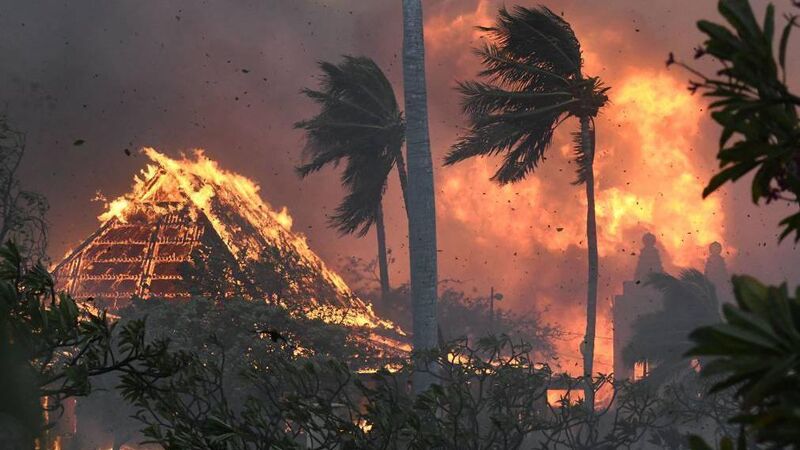Burning questions around spread of wildfires

A church in Lahaina, Hawaii, is engulfed in flames last month. Picture: Matthew Thayer
FIRE has been marauding its way across vast swathes of the western world in recent years, filling our media landscape with churning skies of smoke, crawling red blazes, and citizens clasping rags to their mouths escaping from the encroaching black tide.
This year, Europe, Canada, and Hawaii have experienced events that have captured global discourse and spread ever more dread with regards that all too familiar threat of climate change.
However, there is a rather large aspect of this problem that is often neglected, and that is the ecological function of fire itself. Is fire purely a symbol of hellscape? Or does fire perform duties many of us are unaware of?
Wildfires are broadly categorised as events that occur outside of human planning and control. For an ecologist, they represent a specific type of abiotic force that has potential to shape an environment.
Natural phenomena like floods, droughts, and hurricanes, mould environments which in-turn shape ecosystem compositions.
Ecologically speaking, for the most part these phenomena are not catastrophes, they have always and will always occur. Sometimes, sensitive ecosystems that have not evolved alongside these phenomena get disrupted and disassembled by them, but ecosystems always reassemble again, in one form or another.
Nature knows how to deal with fire - human civilisation is what struggles. Due to this overlapping tension, wildfires have become a problematic socio-ecological issue.
The components required to produce wildfires are fuel of sufficient combustive material, climatic conditions to exacerbate combustion, and an initial source of ignition. They can start naturally or at the hands of humans, and spread as a result of a variety of conditions beyond ecological ones; urban sprawl and an excess of flammable materials, for example.
Several biomes such as savannas, prairies, and coniferous forests have adapted to wildfires and actually rely on them for regeneration. This is counterintuitive given how fire is destructive, but fire helps to eliminate excess decaying material and speeds up the nutrient cycle, enriching the soil quicker.
Many coniferous trees actually have a flammable component. Ever notice the excess pine needles on the floor of a pine plantation? Those decay very slowly, suffocating the forest floor, preventing organisms from growing. Fire solves that problem when it ignites the flammable resin inside those pine needles and sweeps across a land, regenerating the soil, and opening up the forest floor to sunlight again.
Destructive or productive?
Animal casualties are often quite low in ecosystems that are adapted to wildfires, as they flee or burrow to safety. Conversely, invasive species that have not yet adapted can often be wiped out.
Negative or positive?
There is a fine balance between society and nature, and an equally fine balance between fire suppression and allowing fires to occur naturally. A certain amount of fire is required in many natural systems across the globe, and agriculturalists often mimic wildfire with periodic-prescribed-burns to fertilize their land and to eliminate surplus flammable matter.
Not all fire is bad, and not all fire is strictly because of climate change.
Given the large percentage of human-caused fires, it’s fair to consider them as socio-ecological hazards. To lump all the blame purely on climate conditions seems too narrow a causation. If people disposed of cigarettes correctly and lit campfires responsibly, how fewer wildfires would we see? Although, lightning strikes (another source of ignition) are also seemingly increasing due to atmospheric warming.
Between 1998 and 2015, the total acreage of land globally burned due to wildfire fell by 24% according to NASA satellite technology and a publication in Science. This was said to be caused by a livelihood shift from nomadic tribal lifestyles to more settled, agriculturally based lifestyles in places like South America, the Eurasian Steppe, but mainly Africa’s savannas.
It is said Africa used to burn as much land as half the U.S every year. A lot was burned intentionally to keep pasture productive and free from shrubs, and a lot occurred naturally.
Nowadays, agricultural settlements have taken over vast swathes of land so the need for the same kind of burning has much diminished. Not only has it diminished, but communities now actively work to prevent fires from occurring and destroying their croplands.
The same study noted warming at higher latitudes resulted in increased fires events, however, the decrease in mid-latitudes led to an overall decrease. The increase in European fires seems to be a result of high-latitudinal warming, as Europe’s wildfire season is starting sooner than expected, but lest we forget the other reasons of human causation, also.
Another 2022 Science Direct publication noted that, from 2004-2019, global fire incidences decreased in frequency by 11%. The wilderness-urban interface is intensifying with an increase in population and human dwelling near hazardous wooded areas, leading to a rise of human risk and infrastructure damage.
The regions experiencing wildfires with more frequency and intensity are those not as equipped to manage them, such as southern European countries like Spain, France, Italy and Greece. They do experience large areas of wildfire annually; however the earlier season and intensity of recent years has created a large problem for these holiday destinations.
Like any complicated problem, there is a myriad of factors at play.
Prolonged periods of drought is the most obvious one, creating an environment more easily engulfed in flames.
It has also been suggested that the evacuation of agricultural areas by younger people and the concentration in urban sprawls also plays a factor. Land management was easier when there were more active and responsible farmers populating the countryside.
Also, ironically, an increase in green biomass throughout the countryside creates an increase of flammable material which allows wildfire to spread. It has been reported that over 20,000 hectares of Natura 2000 protected areas have burned.
Dr Johann Georg Goldammer, of the Max Planck Institute of Chemistry, has suggested careful forestry and land management will prevent the root causes. But this is long-term thinking and it’s difficult to prove the benefits of preventing fires that have never happened.
Perhaps, with these few difficult years and the onerous potential of more flames on the horizon, the topic of land management will become a more actionable concern and practice.







 App?
App?




